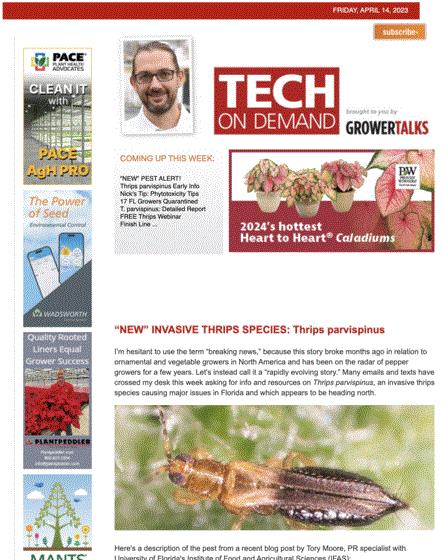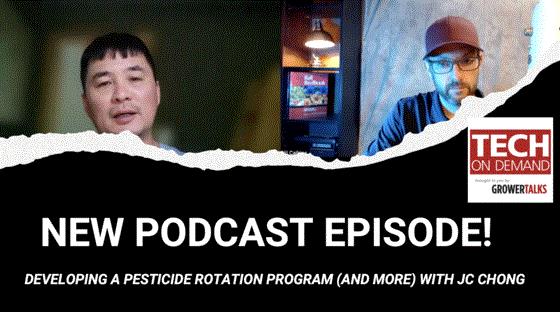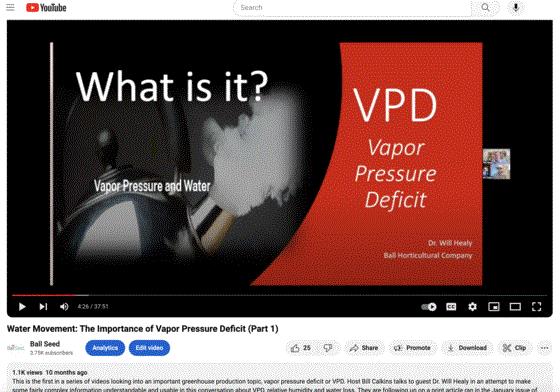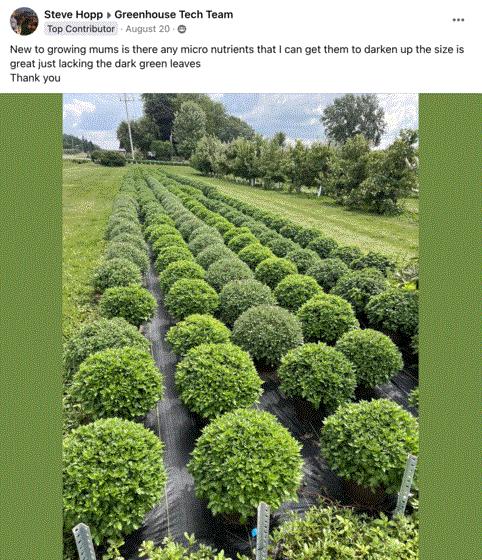#2023Wrapped
You’ve most likely seen social media posts of lists recapping 2023. I think this year the trend was kicked off by Spotify creating individual, customized content for subscribers, letting them know their annual consumption of songs and artists. These were served up to subscribers as 2023 Wrapped—as in “it’s a wrap”—and the hashtag #2023wrapped permeated social media for a week.

On a personal note … my wife and I and our two teenage daughters share a Spotify account and our #2023Wrapped was dominated by my youngest and her obsession with electronic dance DJs. One of my goals for 2024 is to get Skynyrd into the top 5, which won’t be easy. But I digress …
I thought it would be fun to look back at the past year and find out what Tech On Demand content across our multimedia platforms performed the best in terms of total impressions or generated the most positive feedback from growers. In this newsletter, I’ll share the top video, podcast, complete newsletter and Greenhouse Tech Team Facebook post. With a total audience of more than 100,000 per month (across the platforms), this will give a good idea of what was of interest and most relevant over the past calendar year.

Most-Opened Newsletter of 2023
This newsletter is opened by a lot of recipients each week. In fact, the average open rate continues to increase, and when I track the overall Tech On Demand content stats across all our platforms each month, it consistently ranks at the top of the impressions list. Looking back over the past year, one edition was the clear winner, in terms of open rate and total number of growers reached—13% higher than average!

On April 14, I sent THIS NEWSLETTER after spending dozens of hours researching, watching webinars and talking to experts about the hot topic of the day, Thrips parvispinus. After hearing reports of as many as 17 nurseries in Florida facing quarantine and the rapid movement of the pest throughout the country on tropical plant shipments, many of you were in a panic. I tried to bring the latest and most up-to-date information to that Friday’s newsletter and share as many vetted resources as I could find.
University of Florida's Institute of Food and Agricultural Sciences (IFAS) quickly developed a website to share information as it became available, and research projects were quickly planned to learn more about the pest and identify potential control and mitigation strategies. Early next year, I plan to follow up on the latest Thrips parvispinus research findings and do my best to quantify the risk in 2024.

Nick’s Tip of the Week: Get Ready for Spring 2024—Understanding Alkalinity
Each week, I’ll work with my buddy Nick Flax, a technical services expert at Ball, to share a concern that’s come up during one of his numerous calls with growers across North America. This week, he’s continuing a series to help you prepare for spring with a look at why it’s critical to monitor water alkalinity.
PROBLEM: Now that you’ve sent a water sample off for testing, results should be back soon, and you need to know what to do with that information. The long list of water quality parameters that labs report can seem daunting when you receive the readout, so I’ll break it down into a few digestible chunks over the next couple of weeks.

NICK’S TIP: First, let’s talk about alkalinity—arguably the most important water quality parameter to monitor and manage for floriculture producers who grow crops in soilless media.
Alkalinity Core Concepts
Not to be confused with the term “alkaline” (meaning a pH above 7.0), alkalinity is a measure of your water’s buffering capacity—its ability to neutralize acid.
Alkalinity is most often reported as ppm CaCO3 (sometimes written as mg/L; 1 ppm = 1 mg/L) or meq/L. This value indicates the concentration of calcium, magnesium and sodium carbonates and/or bicarbonates present in your water.
As water reacts with things like fertilizer (water-soluble [WSF] or controlled release [CRF]), soil amendments, acids produced by roots in the growing media and the growing media itself, these carbonates and bicarbonates break down, causing soil pH to increase over time. Keep the following in mind as you review alkalinity on your water report:
- The top take-home message is … too-high alkalinity often means more crop challenges.
- About 50 ppm CaCO3 = 1 meq/L (milliequivalent)
- Ideal alkalinity levels for greenhouse growers range from about 50 to 75 ppm CaCO3.
-
Alkalinity greater than 75 ppm often makes high-quality young plant production challenging. Alkalinity between 75 and 150 ppm is often workable for finished plant production simply by using an acidic fertilizer formulation. Minimal intervention is generally needed, but low-pH-loving crops (like Petunia and Calibrachoa) may develop iron (Fe) deficiency later in production if alkalinity is on the higher end of this range.
- Alkalinity greater than 150 ppm often requires raw water to be acidified through a separate injection system before blending with WSF.
-
AlkCalc (currently hosted by our friends at e-GRO) is a great online tool that you can use to determine how much acid is needed to bring your alkalinity down to a manageable level. Be sure to check it out!
-
Sulfuric acid is one of the preferred acids among growers, as it is relatively easy to source and doesn’t heavily alter the nutrient balance of your fertilizer solution.
-
Phosphoric and nitric acids are other options commonly used for to manage alkalinity. However, these will increase the total phosphorous (P) and nitrogen (N) levels (respectively) in your feed. For example (per AlkCalc): If alkalinity is 180 ppm CaCO3 and you want to lower it to 125 ppm, sulfuric acid will add approximately 27 ppm of sulfur (S), whereas phosphoric acid will add about 50 ppm of P. Adding 27 ppm of S likely won’t change anything but 50 ppm of P is a lot more P than plants need and will undoubtedly have a negative impact on crop quality.
- Too-low alkalinity (less than 40 ppm CaCO3), while less common, presents its own unique set of challenges. Think of your target soil pH like a lane in a bowling alley and appropriate amounts of alkalinity in your water like bumpers.
-
Bumpers prevent your ball from rolling into the gutter and help keep the ball (roughly) in the center of the lane. In a similar way, alkalinity helps keep your soil pH “out of the gutter” by neutralizing various acids in the media.
-
To replenish your buffer (or “get the bumpers to pop up each time it’s your turn to bowl”), small doses of alkalinity need to be added to the media at each irrigation.
-
Since low-alkalinity water does not replenish much buffering capacity (or “raise the bumpers”), it becomes easier for soil pH to spike or crash as your media’s lime charge depletes. In turn, this causes nutrient deficiencies and toxicities to induce very quickly as the soil pH swings up and down, especially as the crop matures and acidic reactions (such as respiration and cation uptake) in the root zone occur in greater quantity.
- When alkalinity in your water is excessively high (ex. greater than 250 ppm CaCO3), acid injection alone may not be enough to correct it without being cost-prohibitive or causing nutrient imbalances in your feed program.
-
In this situation, use of reverse osmosis (RO) is often necessary, despite the typically high cost of installing and maintaining these types of systems.
-
Blending RO water with raw water can reduce alkalinity to acceptable levels for good crop growth or make it feasible for acid injection and fertilizer selection to “do the rest.”

Most Downloaded Podcast of 2023
With almost 100 podcast episodes released under the Tech On Demand platform, tens of thousands of downloads have been generated and I hear from so many of you who appreciate the audio format. But which podcast was the most popular in 2023?
First, I want to give an honorable mention to a three-part podcast miniseries on vapor pressure deficit recorded with Dr. Will Healy. Adding up the three episode downloads, this topic would take the win. More on that later …
THE SINGLE EPISODE WITH THE MOST DOWNLOADS was from July 24, featuring JC Chong, a technical development manager at SePRO, discussing the importance of pesticide rotation programs and how to develop and implement them in your operation.

JC and I dug into exactly why resistance programs are critical to reducing resistance and why resistance leads not only to reduced options and crop issues but also higher costs. Then we moved into resources and tips to navigate the oftentimes puzzling world of insecticide rotation. JC explained why rotating modes of actions and not trade names is necessary, as well as how many modes of action should be used in an effective rotation. Finally, we went even deeper into how you can customize rotations for your needs using the tools and resources JC employs when he consults with greenhouse and nursery growers.
Be sure to subscribe to the Tech On Demand Podcast, brought to you by GrowerTalks on your favorite app, like Apple, Spotify, Google, Audacy and more. That way you’ll never miss an episode. And if you have a few seconds, please leave a positive rating or review to help our algorithm.

2023’s Most Watched Tech On Demand Video
I mentioned vapor pressure deficit (VPD) as a popular podcast discussion above, but it was even more popular on YouTube. Dr. Will Healy’s WATER MOVEMENT: THE IMPORTANCE OF VAPOR PRESSURE DEFICIT was our top video of 2024. When more than 1,000 growers tune in to a video presentation online, the topic must be relevant and something that generates a lot of questions that need answers.

In this video, Will and I tried to clarify the importance of VPD and relative humidity (RH), as well as explaining the process of evapotranspiration. The video set the stage for upcoming presentations covering when VPD is most critical and ways to manage this integral piece of your greenhouse environment puzzle. After recording videos and podcasts on VPD, I actually compiled a lot of the information he shared into an ARTICLE for GrowerTalks.
Here's an excerpt from the story addressing the question, “Why use VPD?”
Millions of crops have been grown successfully without ever taking a VPD measurement. However, Will explains there are many positive impacts that are realized when incorporating VPD in your greenhouse, from propagation to production to finishing. Furthermore, the benefits of VPD management on insect and disease control can be dramatic and help reduce chemical use, labor and ultimately result in higher-quality crops across the board. In a nutshell, you and your team will water based on your crops’ specific water loss versus dates on a calendar. VPD allows for tremendous accuracy.
“In propagation, using VPD to maintain proper URC hydration and turgidity during rooting helps get crops off to a strong start. Reducing soil moisture as roots begin to develop is another critical benefit,” Will said. “Moving into the main production stage, using VPD to more accurately manage and control irrigation results in faster growth and lower disease and insect pressure, as well as controlled stem elongation.”
When it comes to insect and disease management, he says employing VPD can help reduce fungal spore germination and spread, not to mention the spread of bacteria. Accurately measuring and managing VPD can have a tremendous impact on pests and diseases in young plant production, Will says.
“If crops are too dry, spider mites can explode in your greenhouse, but if they’re too wet, diseases can rapidly occur and spread.” For example, low VPD can result in increased Botrytis risk, among others.
Treating pests and diseases often requires spraying, which in turn adds moisture to the environment and messes up optimal VPD, he adds. Plant disease runs rampant when foliage is wet and the overall greenhouse environment is moist, so maintaining the proper VPD can go a long way toward reducing risk.

Top Greenhouse Tech Team Facebook Group Post
With more than 5,000 members around the world growing just as diverse a mix of crops, the range of posts in our GREENHOUSE TECH TEAM PRIVATE FACEBOOK GROUP is wide and diverse. Overall daily engagement is extremely high, and in a peer-to-peer community of greenhouse professionals, you can be sure most questions posted generate multiple comments.

I thought it would be interesting to attempt to determine the post with the most engagement over the last year. Using the magic of Facebook Insights, I believe the top post, in terms of engagement, including total impressions, likes and comments, was a garden mum question posted on August 20.
Steve Hopp at Golz Orchard & Farm Market in Waupun, Wisconsin, posted a photo of his mum field and asked about micronutrients suggested to darken up the crop. He felt the mums were sizing up well but lacking dark green foliage. Thanks to our awesome community, he quickly received dozens of comments including suggestions for solving the problem, congrats for taking the initiative to increase his crop from 400 to 1,500 this year, and kind words about the quality of his mums.
I was impressed by the total engagement (almost 2,000 members saw the post that day) but to be honest, what stood out most was the positivity and encouragement show by our group to a relatively new mum grower. He posted pics later showing the progress of the crop as it started showing color and it sure seems like the community helped Steve get on the right track to healthy, top-quality mums.

Finish Line …
It was interesting to look back at the content from Tech On Demand in 2023 and I feel like we really hit our stride, and like all grassroots online efforts, the impact snowballs. The more that people engage with the videos, podcasts, newsletter and social media, the more impressions they generate. That means all of you who read the newsletter and click the links are helping us reach more greenhouse professionals. For that, I’m truly grateful.
One of my coworkers commented this week that horticulture is the intersection of plants and people, and I feel like our multimedia approach to sharing cultural and technical information reflects this. Looking forward to 2024, my goal is to continue working with experts across the industry to bring you research and trial findings, tips and tricks to help you grow your best crops ever.
The Tech On Demand team has a ton of new ideas to make content more accessible and useful for training your new team members and helping you hone your skills with the latest production strategies. Think short, less-than-a-minute videos, training modules, and crop-specific production plans taking you from propagation to finish. And in keeping with our mission, these will be available in audio, video and white paper formats.
As we wrap up and tie a bow on 2023, it’s been fun to look back and see how many of you support what we do. One hundred thousand impressions every month in an industry the size of ours isn’t something we take for granted. Talk to you next week!



Please feel free to send your comments, constructive criticism and topic ideas to me at bcalkins@ballhort.com.

Bill Calkins
Editor - Tech On Demand
This email was received by you and 26,034 other fine subscribers!
If you're interested in advertising in Tech On Demand, contact Kim Brown ASAP and she'll hook you up.